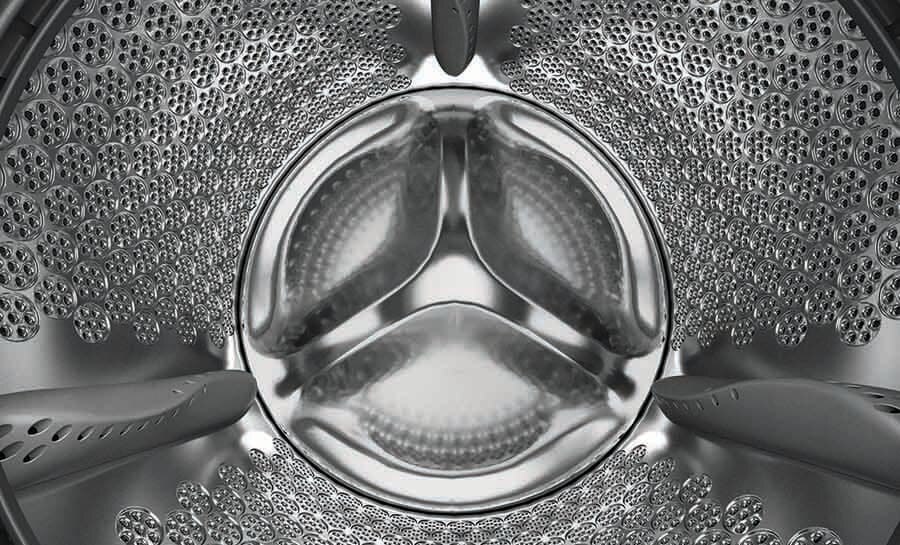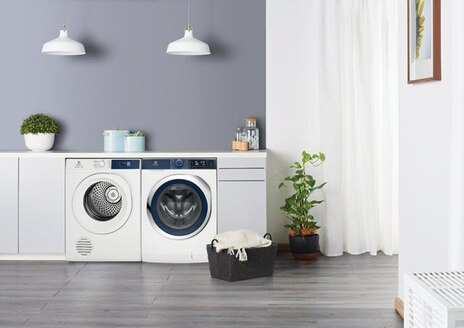1. Types of washing machine
If you’re in the market for new laundry appliances you’re most likely choosing between a front load washing machine and a top load washing machine. There are advantages to both - top loaders have slightly larger capacity than their front-loading counterparts and can be cheaper to purchase, but front-loaders are gentler on clothes and significantly more energy-efficient to run, meaning you save money (and the environment) over the long term.
2. Water efficiency
The New Zealand Water Efficiency Labelling and Standards (WELS) scheme is a government initiative that helps consumers understand the way their whitegoods use water. A star rating helps consumers evaluate at a glance the efficiency of their products - the more stars, the more efficient it is. The aim is to use as little water as possible to achieve the best clean for your laundry, and there are several ways in which this can be achieved through optimising your machine’s settings.
The average front load washing machine will use about 60 litres of water for a normal load, with less for a fast-cycle and more for an intense wash, which is why pre-treating or soaking soiled items before washing them on a normal cycle is an excellent choice.
A pro tip for going the extra mile with water conservation is to have your washing machine drain into a bucket which can then be used in the garden. Every little bit helps, and that’s hundreds of litres of water recycled per year.
The average front load washing machine will use about 60 litres of water for a normal load, with less for a fast-cycle and more for an intense wash, which is why pre-treating or soaking soiled items before washing them on a normal cycle is an excellent choice.
A pro tip for going the extra mile with water conservation is to have your washing machine drain into a bucket which can then be used in the garden. Every little bit helps, and that’s hundreds of litres of water recycled per year.

3. Energy efficiency
Not only do front load washing machines have a better report card on water efficiency, but they use less energy as well. Because a top load washing machine is required to constantly spin clothes around inside the drum, it requires consistent movement and therefore, constant power. A front loader only needs to spin 180 degrees clockwise before the clothes naturally tumble to the bottom of the drum again, effectively halving the amount of energy it requires to run.
The New Zealand Energy Star-Rating scheme allows consumers to compare their products with similar models to understand how much energy they consume. The more stars, the more energy efficient a product is.
The way you choose to use your appliance is just as important as the energy rating you choose, and there are several ways in which you can maximise efficiency. Washing machines require electricity to heat the water they use (they only connect to the cold tap, meaning all heat needs to come from the machine itself), so choosing to wash on a cold cycle is one of the best ways to reduce your energy consumption. Additionally, all Electrolux washing machines come with an eco setting, allowing you to run a load at the machine’s most energy-efficient setting without compromising on cleanliness.
The New Zealand Energy Star-Rating scheme allows consumers to compare their products with similar models to understand how much energy they consume. The more stars, the more energy efficient a product is.
The way you choose to use your appliance is just as important as the energy rating you choose, and there are several ways in which you can maximise efficiency. Washing machines require electricity to heat the water they use (they only connect to the cold tap, meaning all heat needs to come from the machine itself), so choosing to wash on a cold cycle is one of the best ways to reduce your energy consumption. Additionally, all Electrolux washing machines come with an eco setting, allowing you to run a load at the machine’s most energy-efficient setting without compromising on cleanliness.

4. Washing machine capacity
Is it just the two of you or do you have a family of 10? Electrolux washing machines range from 5 to 10 kilograms for dry clothes (an 8kg washing machine can take up to 40 shirts at a time). With clever features like our direct spray washing technology, which adjusts water and energy consumption according to the size of your load, you can rest assured that there will be no energy or water wastage.
1 - 2 people: A 4-6.5kg washing machine suits single or small households fitting around 5 outfits or 5 towels per load.
3 - 4 people: A 7kg-8.5kg washing machine suits medium households, fitting around 7 outfits or 7 towels per load.
5+ people: A 9kg or bigger washing machine suits large households, fitting 8+ outfits or 8+ towels per load.
1 - 2 people: A 4-6.5kg washing machine suits single or small households fitting around 5 outfits or 5 towels per load.
3 - 4 people: A 7kg-8.5kg washing machine suits medium households, fitting around 7 outfits or 7 towels per load.
5+ people: A 9kg or bigger washing machine suits large households, fitting 8+ outfits or 8+ towels per load.
5. Wash cycles and settings
Understanding the proper use of your cycle-settings means getting the most out of your clothes long term.
| Wash cycle |
Usage
|
|---|---|
| Energy Saver | A program that uses lower water volume and temperature to save on energy while still cleaning your garments to an acceptable standard. |
| Delicate/Bedding |
For items that need less rigorous washing, this gentler cycle is perfect.
|
|
Extra dirty/machine clean
|
For heavily stained or soiled loads, or for use with a washing machine cleaning product to keep the drum sanitised and fresh.
|
|
Spin/Rinse and spin
|
A setting that simply rinses (without detergent) and spins to remove excess moisture.
|
|
Wool
|
A gentle cycle that only heats water to 40 degrees celsius in order to preserve the delicate fibres of wool garments.
|
|
Quick 15
|
A super-fast wash cycle, cleaning your clothes in only 15 minutes. Not recommended for very stained or soiled loads.
|
|
Daily 39
|
Ideal for cottons and regular, everyday loads, this is a great go-to setting.
|
|
Full Wash 60
|
Ideal for a very full load, this setting washes your garments at 60 degrees celsius, usually over a longer period of time.
|
|
Sports
|
A gentle program designed for mixed fabrics found in delicate clothes.
|
|
Vapour Refresh
|
This cycle removes odours and helps to de-wrinkle the laundry, without detergent.
|
6. Sustainability
Sustainability is at the core of everything we do at Electrolux, and a big focus of our laundry range. The way you wash your clothes can make a huge difference in your efforts to create a more sustainable home. For example:
- Using the correct settings on your washing machine ensure your clothes last longer, reducing turnover and fast fashion purchasing
- Choosing to take advantage of cold washing/eco settings means reducing your energy footprint with each load
- Buying a front load washing machine allows you to wash your clothes at a third of the energy usage required by a top loader
- Draining your machine into a bucket and re-using the water in the garden is a simple and effortless way to recycle thousands of litres of water
7. Accessories
To make your laundry even more efficient, our laundry pedestal raises your front load washing machine to optimal working height, providing a handy drawer underneath. If you’re looking for a way to stack your dryer on top of your washer without having to mount it to the wall, try our laundry stacking kit, designed specifically for Electrolux washers and condenser dryers — featuring a convenient pull-out bench, integrated handle and a white facade to match the washing machine and dryer.
8. How to clean your washing machine
For consistent results, a few simple maintenance measures will keep things running smoothly. Don’t forget to flush out and clean your washing machine’s drain and lint-catcher regularly - you can find detailed instructions on Pg 25 of our user manual. In addition, wiping down the door seals with vinegar is an environmentally-friendly and cheap way to help prevent mould and mildew forming.
9. FAQs
-
What temperature water should I use to wash my clothes?
Your choice of water temperature needs to take into consideration the kind of care-requirements of the garments you’re washing.
In order to kill dust mites, for example, your water needs to be 60 degrees celsius or hotter. Want to save on energy? In that case, a cold wash is the best choice, and if your garments are delicate or likely to shrink when exposed to heat, this will affect which setting you choose. -
Are front load washing machines better for your clothes?
Not only do front load washing machines include more settings, making it easier to select the right choice for your garments, but they’re also physically gentler in the washing process, meaning your clothes last longer.
-
Are front load washing machines better than top load washing machines?
Environmentally speaking, front load washing machines far exceed the energy-saving capabilities of their top load counterparts. In addition, they’ve been shown to be gentler on clothes and tougher on stains - an excellent choice for any household.
-
Do front load washing machines clean clothes better?
Front load washing machines are not only gentler on clothes as a result of there being less agitation involved in a cycle, but they’ve also been shown to be tougher on stains.
-
Does my washing machine need a hot and cold tap?
While your washing machine comes with a range of temperature options, you only need a cold water tap to connect to it - the machine will heat the water to the required temperature while it’s in use.
-
How long is a normal wash cycle?
While there are small variations between different models, an average ‘normal’ cycle is a little over an hour.






